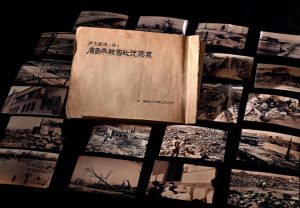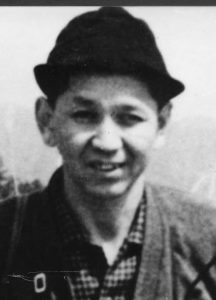Striving to fill voids in Hiroshima: Photo album containing 19 “original prints” taken by Yotsugi Kawahara immediately after A-bombing to be donated to Peace Memorial Museum
Apr. 24, 2022
Kawahara, former member of Imperial Japanese Army, participated in survey of A-bombing devastation
by Kyosuke Mizukawa, Staff Writer
A photo album titled “Photographs of A-bomb Damage in Hiroshima,” left behind by Yotsugi Kawahara upon his death in 1972 at the age of 49, will soon be donated to the Hiroshima Peace Memorial Museum (in the city’s Naka Ward). Mr. Kawahara was a member of the photographic team of the Imperial Japanese Army as one of the photographers who worked to capture images of Hiroshima immediately after the atomic bombing. Although Mr. Kawahara is said to have disposed of negatives of the photos by order of the Japanese Army, he held on to original prints of 19 of the images taken at that time. The album contains a total of 23 photos, including the 19 images he kept for himself. The album represents invaluable information that vividly communicates to the present day the horrific consequences of the atomic bombing.
During World War II, Mr. Kawahara belonged to the photographic team of the Imperial Japanese Army’s Shipping Command, located in the area of Ujina-cho in Hiroshima City (now part of the city’s Minami Ward). Immediately after the atomic bombing, he traveled around the city taking photos of the A-bombing devastation as part of a survey team put together by the army. The handmade album was apparently assembled in the days after the end of the war and contains the photos pasted on paper pages, with notations about the location where the photo had been taken.
The 19 photos captured numerous and varied locations, including a temporary first-aid station full of the wounded along the Honkawa River, the devastation in the area around the Fukuya Department Store, and an intersection in the area of Kamiya-cho (now part of the Hiroshima’s Naka Ward) where an incinerated streetcar lay in ruins. Most of the photos are thought to have been taken on August 9, 1945, three days after the atomic bombing of Hiroshima by the U.S. military, a relatively early point in time relative to other existing photos taken after the atomic bombing. The album also contains four photos of the wounded taken by Masami Onuka, a member of the same photographic team on which Mr. Kawahara served.
In 1968, 23 years after the atomic bombing, Mr. Kawahara and Mr. Onuka unveiled the album to the public for the first time in the form of a series of original prints at Hiroshima City Hall, identifying themselves to be the photographers. At the time, they revealed they had disposed of the negatives by burning or burying them in the ground by order of the Imperial Japanese Army immediately after the end of the war. They also explained, however, that they had created the album to archive the original photographic prints in possession of all the members of the photographic team.
Mr. Kawahara died four years after he had shown the album to the public. Mr. Kawahara's wife, Nuiko, held on to the album after that time, with the Chugoku Shimbun reporting its existence in 2005. After Nuiko died in 2010 at the age of 89, her oldest son, Yuichi, 74, a resident of Hiroshima’s Minami Ward, inherited the album. Yuichi recently decided to donate the album to the Hiroshima Peace Memorial Museum with the aim of preserving its contents for future generations.
(Originally published on April 24, 2022)









